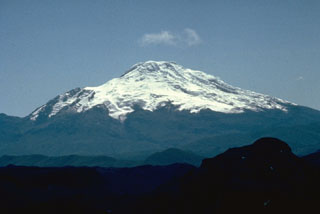Report on Cayambe (Ecuador) — 14 December-20 December 2016
Smithsonian Institution / US Geological Survey
Weekly Volcanic Activity Report, 14 December-20 December 2016
Managing Editor: Sally Sennert.
Please cite this report as:
Global Volcanism Program, 2016. Report on Cayambe (Ecuador) (Sennert, S, ed.). Weekly Volcanic Activity Report, 14 December-20 December 2016. Smithsonian Institution and US Geological Survey.
Cayambe
Ecuador
0.029°N, 77.986°W; summit elev. 5790 m
All times are local (unless otherwise noted)
IG reported that a seismic swarm detected at Cayambe on 5 June was characterized by an increase in the number of volcano-tectonic events. The swarm occurred near an active fault system, NE of the volcano. The seismic activity progressively declined to baseline levels during August. A minor increase was again observed in September, with events migrating to locations underneath the volcano, and then became more pronounced in November. Anomalously large-magnitude earthquakes occurred on 14 November (M 3.3) and on 27 November (M 3.6). Another swarm was also detected on 27 November. Seismicity continued above baseline levels through 2 December. In addition, climbers reported an increase in a sulfur odor.
On 13 December IG noted that during the previous week there was an average of 68 earthquakes/day, mainly volcano-tectonic events and some long-period signals. A M3 event located at a depth of 7 km below the summit was recorded on 8 December. Climbers continued to report an increase in a sulfur odor, and also the presence of new cracks in the glacier near the summit.
Geological Summary. The massive compound andesitic-dacitic Cayambe stratovolcano is located on the western edge of the Cordillera Real, east of the Inter-Andean Valley. The volcano, whose southern flank is on the equator, is capped by extensive glaciers. The modern Nevado Cayambe, constructed to the east of older Pleistocene volcanic complexes, contains two summit lava domes about 1.5 km apart. Several other lava domes on the upper flanks have been the source of pyroclastic flows that reached the lower flanks. A prominent Holocene pyroclastic cone on the lower E flank, La Virgen, fed thick andesitic lava flows that traveled about 10 km E. Nevado Cayambe has also produced frequent explosive eruptions beginning about 4,000 years ago, with the most recent known activity during 1785-86.
Source: Instituto Geofísico-Escuela Politécnica Nacional (IG-EPN)

